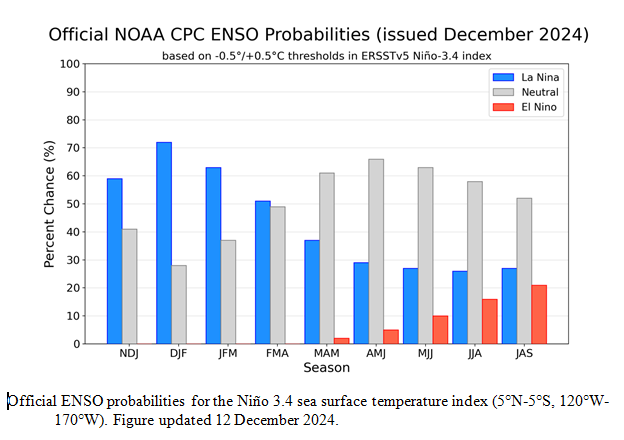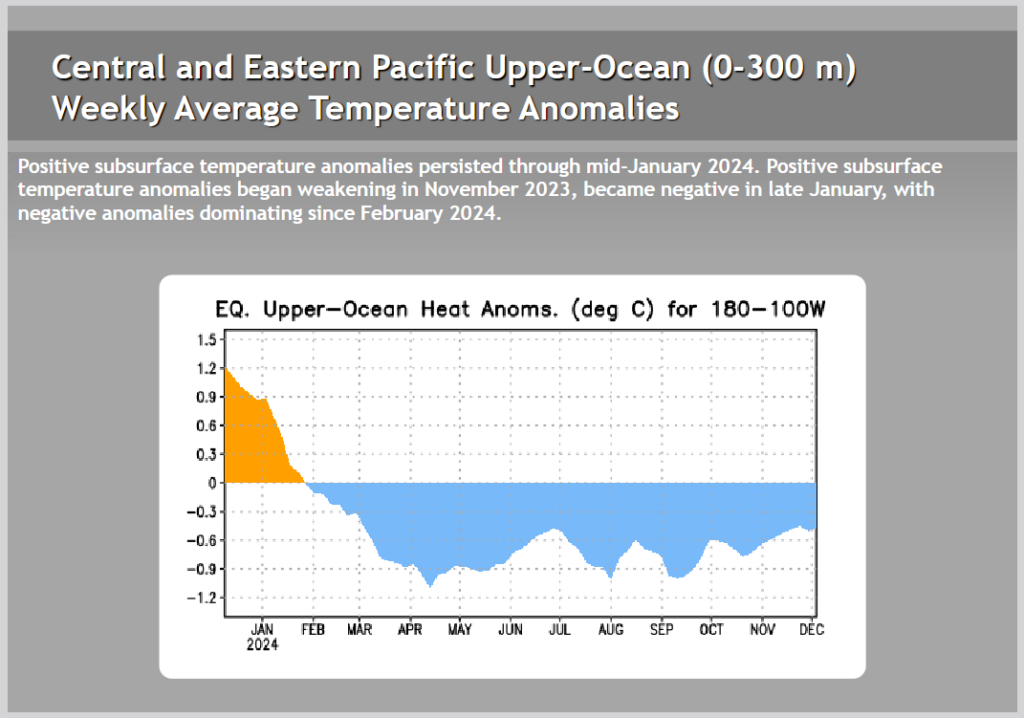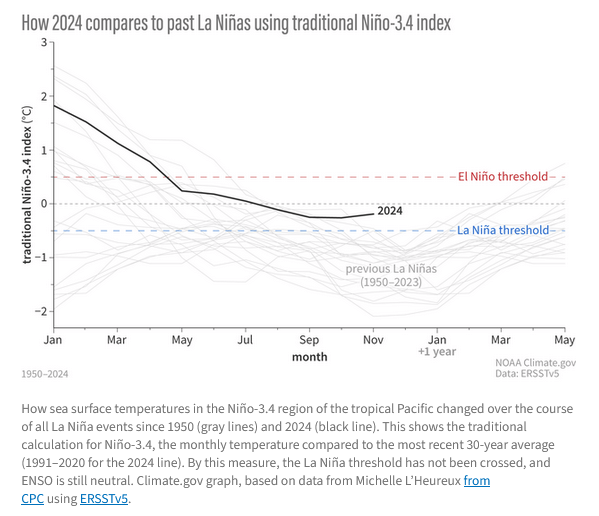“Synopsis: “La Niña conditions are most likely to emerge in November 2024 – January 2025 (59% chance), with a transition to ENSO-neutral most likely by March-May 2025 (61% chance).“
So we continue to be in ENSO Neutral but NOAA may not want to admit their forecast was wrong so they present it as waiting for La Nina. It is correct that we are in La Nina Watch but it is also correct that we currently still remain in ENSO Neutral.
On the second Thursday of every month, NOAA (really their Climate Prediction Center CPC) issues its analysis of the status of ENSO. This includes determining the Alert System Status. NOAA now describes their conclusion as “ENSO Alert System Status: La Nino Watch”
The exact timing of the transition is now perhaps more clear but maybe not. It should increase the reliability of the Seasonal Outlook to be issued next Thursday. But will it?
BTW this is the Copernicus view of the next three months.
| The above is a consolidation of a number of models including one of the U.S. models but it is dominated by European models. The format is different than what NOAA will present next week. It is more technical in nature. Basically this graphic shows the expected average storm track over the three-month period. It also shows the expected deviation from normal of the level of the 500 MB ((Z500) of air- pressure which is pretty much the midpoint of the atmosphere. Z 500 is often the best way to forecast weather. Remember this is not a weather forecast but a forecast of the average air pressure for the three months. It will vary from day to day and week to week but the storm track is expected to be further north which usually divides the cold and wet area from the warm and dry area but we are talking about anomalies. I suspect that the NOAA forecast which will be issued next Thursday will be similar to the above. It is suggesting a La Nina pattern. |
We have included a very interesting ENSO Blog Post by Emily Becker.

CLIMATE PREDICTION CENTER ENSO DISCUSSION (LINK)
| The second paragraph is what is important:
“The dynamical models in the IRI plume continue to predict a weak and a short duration La Niña, as indicated by the Niño-3.4 index values less than -0.5°C. This prediction is also reflected in the latest North American Multi-Model Ensemble (NMME), which continues to predict slightly cooler SSTs and weak La Nina conditions. The forecast team leaned toward predicting an eventual onset of weak and short-lived La Nina conditions, based on the model guidance and current atmospheric anomalies. Weak La Niña conditions would be less likely to result in conventional winter impacts, though predictable signals could still influence the forecast guidance (e.g., CPC’s seasonal outlooks). In summary, La Niña conditions are most likely to emerge in November 2024 – January 2025 (59% chance), with a transition to ENSO-neutral most likely by March-May 2025 (61% chance).” Below is the middle paragraph from the discussion last month. “The IRI plume predicts a weak and short duration La Niña, as indicated by the Niño-3.4 index values less than -0.5°C. The latest North American Multi-Model Ensemble (NMME) forecasts are cooler than the IRI plume and predict a weak La Niña. Due to this guidance and La Niña-like atmospheric circulation anomalies over the tropics, the team still favors the onset of La Niña, but it is likely to remain weak and have a shorter duration than other historical episodes. A weak La Niña would be less likely to result in conventional winter impacts, though predictable signals could still influence the forecast guidance (e.g., CPC’s seasonal outlooks). In summary, La Niña is most likely to emerge in October-December 2024 (57% chance) and is expected to persist through January-March 2025).” |
We now provide additional details.
CPC Probability Distribution
Here are the new forecast probabilities. The probabilities are for three-month periods e.g. NDJ stands for November/December/January.
![]() Here is the forecast from last month.
Here is the forecast from last month.
| The analysis this month and last month are a bit different with again the transition to La Nina being slightly slower than thought last month. Also, the probabilities of a La Nina are lower than estimated last month. This seems to be a trend. The chart is clearer than the discussion in the summary report above. The La Nina is a bit slower to arrive. I am not sure that we will actually have a La Nina. However, one should read the Blog Post by Emily Becker, which is discussed later in this article. |
Some will need to click on “Read More” to read the rest of this article.
Looking at Actual Current Conditions.
NOAA reports some derived data that describes the current situation and a forecast. But what if we want to form our own opinion? After all, meteorologists are looking at the actual current situation and making predictions.
This shows the current situation for the surface of oceans. To update this graphic click HERE.
| You can see some cool water along the Equator but it is not a lot. We are discussing ENSO tonight but you can see a lot of interesting things here. It is only a one-day snapshot so keep that in mind. There is not much warm water along any coast of the United States other than the Gulf of Mexico. |
Putting the historical information in motion. Updates can be found HERE. but should not be needed.

Now we look at the below surface temperature anomalies. Mapping the details. (Cross-Section along the Equator). The data is a five-day average centered on the date shown.
Here is the new map followed by the prior two months to show the progression. The undercutting of the cool water by the warmer water is clear but when does the cool (cooler than usual meaning a cool anomaly) reach the surface? I am only showing the prior two months but the situation has been static for six or more months.
| I am not sure that this La Nina is developing the way the CPC claims that it is. I would not be shocked if it did not develop at all. The situation in the area of interest looks worse than last month.
But a short weak La Nina is the forecast and probably will happen. It seems to be a bit less convincing this month. But if the alternative definition which we discussed last month HERE is used, it looks like an actual but weak La Nina. |
| This shows the water column anomaly is now negative i.e. the warmer water near the surface is dominated by the cooler water below. But the forecast is not for this La Nina to get very intense. The cool anomaly down to 300 meters seems to be weaker but what happens at the surface is what counts. |
Kelvin Waves
Will there now be another upwelling Kelvin Wave? More skepticism on my part related to the NOAA interpretation. |
Is the response of the atmosphere sufficient to sustain an El Nino? This made me want to take a look at the SOI Index, HERE is the U.S. version. HERE is the link to the Australia Bureau of Meteorology (BOM) version of that graph. I prefer the BOM version but there could be an argument that the U.S. version is more accurate but I am not convinced of that. The BOM version dates back to when meteorological stations were more practical on land so they were not exactly on the Equator as is the U.S. version.
With respect to the BOM version,
“The Southern Oscillation Index, or SOI, gives an indication of the development and intensity of El Niño or La Niña events in the Pacific Ocean. The SOI is calculated using the pressure differences between Tahiti and Darwin.
Sustained negative values of the SOI below −7 often indicate El Niño episodes. These negative values are usually accompanied by sustained warming of the central and eastern tropical Pacific Ocean, a decrease in the strength of the Pacific Trade Winds, and a reduction in winter and spring rainfall over much of eastern Australia and the Top End. You can read more about historical El Niño events and their effect on Australia in the Detailed analysis of past El Niño events.
Sustained positive values of the SOI above +7 are typical of a La Niña episode. They are associated with stronger Pacific trade winds and warmer sea temperatures to the north of Australia. Waters in the central and eastern tropical Pacific Ocean become cooler during this time. Together these give an increased probability that eastern and northern Australia will be wetter than normal. You can read more about historical La Niña events and their effect on Australia in the Detailed analysis of past La Niña events.”
| The SOI is now in La Nina territory. |
Assessment of the Australian Bureau of Meteorology (BOM) LINK.
Assessment of JAMSTEC
| The Nino 3.4 forecast made on Dec 1 suggests we are already in marginal La Nina while the Modoki analysis suggests we will touch La Nina conditions in mid-January so that seems unconvincing to me. |
Now we present the recent ENSO Blog Post by Emily Becker.
| So you can see that with the standard definition of La Nina, we are not there but with the Relative Nino 3.34 Index we have been in a weak La Nina for a few months. So it seems that neither approach might be working at this point in time. |
| To do the calculation yourself. THIS link takes you to the code. |
| I hope you found this article interesting and useful. |



















